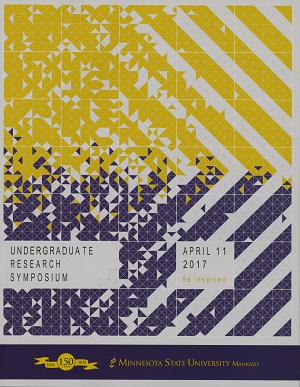Ultrastructure of Larval Trematodes from Snails Collected from Lake Winnibigoshish
Location
CSU Ballroom
Start Date
11-4-2017 10:00 AM
End Date
11-4-2017 11:30 AM
Student's Major
Biological Sciences
Student's College
Science, Engineering and Technology
Mentor's Name
Robert Sorensen
Mentor's Department
Biological Sciences
Mentor's College
Science, Engineering and Technology
Second Mentor's Name
Scott Malotka
Second Mentor's Department
Biological Sciences
Second Mentor's College
Science, Engineering and Technology
Description
Trematodes are a class of parasitic flatworm that are internal parasites of both mollusks and vertebrate hosts. Most trematodes have a complex life cycle that includes at least two hosts: one where sexual reproduction occurs (definitive host) and one where asexual reproduction occurs (intermediate host). Identification of both larval and adult stages is critical for determining the species of trematode in question as well as the mechanisms that allow that parasites to reside within their intermediate host. The current investigation was started to elucidate the mechanisms that allow for parasite attachment within intermediate hosts. Snails were collected from Lake Winnibigoshish in northern Minnesota, an area known for harboring trematode diversity within both definitive and intermediate hosts. During this study, two different larval forms (rediae and tetracotyle) were dissected from snail hosts and prepared for scanning electron microscopy (SEM). Examination of the presence or absence of structures used for the attachment to host tissues will be performed. These findings will help better understand the interaction that occurs between the intermediate snail host and the parasitic worm.
Ultrastructure of Larval Trematodes from Snails Collected from Lake Winnibigoshish
CSU Ballroom
Trematodes are a class of parasitic flatworm that are internal parasites of both mollusks and vertebrate hosts. Most trematodes have a complex life cycle that includes at least two hosts: one where sexual reproduction occurs (definitive host) and one where asexual reproduction occurs (intermediate host). Identification of both larval and adult stages is critical for determining the species of trematode in question as well as the mechanisms that allow that parasites to reside within their intermediate host. The current investigation was started to elucidate the mechanisms that allow for parasite attachment within intermediate hosts. Snails were collected from Lake Winnibigoshish in northern Minnesota, an area known for harboring trematode diversity within both definitive and intermediate hosts. During this study, two different larval forms (rediae and tetracotyle) were dissected from snail hosts and prepared for scanning electron microscopy (SEM). Examination of the presence or absence of structures used for the attachment to host tissues will be performed. These findings will help better understand the interaction that occurs between the intermediate snail host and the parasitic worm.
Recommended Citation
Iverson, Jacob and Ross Buttleman. "Ultrastructure of Larval Trematodes from Snails Collected from Lake Winnibigoshish." Undergraduate Research Symposium, Mankato, MN, April 11, 2017.
https://cornerstone.lib.mnsu.edu/urs/2017/poster-session-A/12



